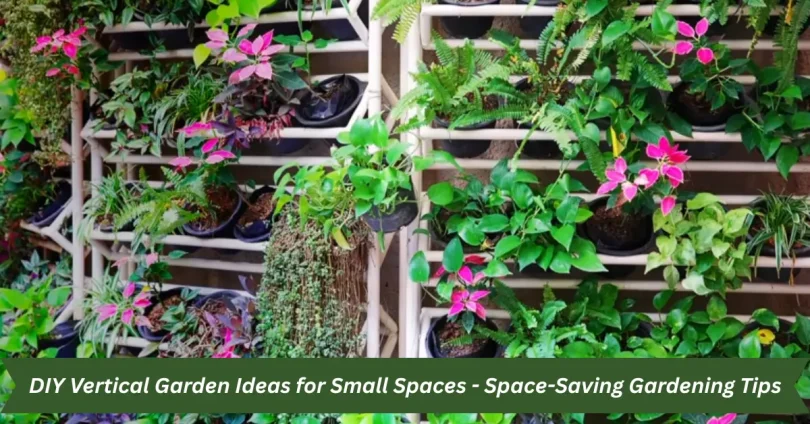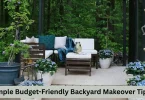Introduction
If you’re living in a small apartment or home with limited outdoor space, don’t worry — you can still enjoy the beauty and benefits of gardening! With a little creativity, you can grow your favorite herbs, flowers, or even vegetables using DIY vertical garden ideas for small spaces. These smart, space-saving gardening tips help you turn empty walls, balconies, or corners into lush green spots without taking up much room.
In this blog post, we’ll show you how to create your own vertical garden step-by-step, using affordable materials and simple techniques. Whether you’re a beginner or a plant lover looking to make the most of a small space, this guide is for you.
What is a DIY Vertical Garden for Small Spaces?

A DIY vertical garden for small spaces is a creative way to grow plants upward instead of outward — perfect for people who don’t have a lot of ground space. Instead of using traditional garden beds, vertical gardens make use of walls, fences, balconies, or narrow corners to hold plants in stacked or hanging containers.
The best part? You can build it yourself using simple materials like wooden pallets, hanging planters, old shelves, or even recycled items like plastic bottles or shoe organizers.
- These gardens are ideal for growing:
- Herbs (like basil, mint, and parsley)
- Small veggies (like lettuce or cherry tomatoes)
- Flowers or decorative plants
- Even air-purifying indoor plants
Whether you’re working with a tiny balcony, an indoor wall, or a small backyard, a DIY vertical garden lets you save space, grow fresh plants, and add beauty to your environment — all at the same time.
You May Also Like It:
Common Tree Diseases and Effective Treatment Methods – Tree Care Guide
Best Time to Trim Trees – Seasonal Guide for Healthy Growth
How to Keep Indoor Plants Healthy | Essential Tips for Thriving Houseplants
Why is DIY Vertical Gardening for Small Spaces Important?
Vertical gardening is more than just a clever way to grow plants — it brings real benefits to people living in compact spaces. Here’s why it matters:
Makes the Most of Small Living Areas
- Saves Floor Space
By growing plants vertically, you free up valuable floor space for other uses. It’s ideal for balconies, patios, or small indoor spots. - Ideal for Apartments and Urban Homes
Most urban homes lack traditional garden space, but vertical gardens fit easily in compact environments. They bring greenery where gardens usually can’t go. - Organized and Tidy Look
Vertical gardens help you keep plants neatly arranged in one place. This adds beauty without cluttering limited space.
Supports a Healthier Lifestyle
- Grows Fresh Herbs and Veggies
Having fresh, homegrown herbs or vegetables within reach encourages healthy eating. It also adds natural flavor to daily meals. - Improves Air Quality
Plants absorb carbon dioxide and release oxygen, making your space feel fresher. Some also filter out indoor air pollutants. - Reduces Stress and Boosts Mood
Studies show that being around plants can lower stress and improve mental focus. A green space, even a small one, creates a calming atmosphere.
Eco-Friendly and Sustainable
- Reuses Old Materials
Vertical gardens can be made using items like wooden pallets, bottles, or fabric pockets. This reduces waste and supports upcycling. - Reduces Carbon Footprint
Growing your own food means fewer trips to the store and less packaging waste. It’s a simple way to live more sustainably. - Encourages Water Efficiency
Many vertical systems use less water and direct it efficiently to roots. Adding drip irrigation makes them even more eco-friendly.
Easy to Maintain
- Simplifies Watering and Care
Plants arranged vertically are easier to reach and manage. You can water, prune, and harvest without much bending or mess. - Less Weeding Needed
Because vertical gardens are raised and compact, weeds are less likely to grow. That means less time spent on garden maintenance. - Good for Beginners
Starting a vertical garden is simple and flexible. It’s a low-risk way for beginners to learn about plant care and gardening.
Step-by-Step Guide: DIY Vertical Garden for Small Spaces

Whether you’re working with a small balcony, wall, or indoor corner, this guide will help you create your own vertical garden from scratch using affordable and reusable materials.
Step 1: Choose the Right Location
- Pick a spot that gets enough sunlight — ideally 4–6 hours a day for most plants.
- Make sure it’s easy to access for watering and protected from heavy wind or rain.
Step 2: Select Your Vertical Structure
- Decide what type of vertical garden setup works best for your space and budget.
- Options include wooden pallets, hanging planters, shelves, wall-mounted pots, or recycled items like shoe organizers.
Step 3: Gather Your Materials
Here’s what you may need:
- Planters or containers (pockets, pots, bottles)
- A frame or wall structure to support the plants
- Potting soil and small stones for drainage
- Seeds or starter plants
- Mounting tools (hooks, nails, brackets, etc.)
Choose materials based on the size of your space and whether the garden will be indoors or outdoors.
Step 4: Prepare Your Containers
- Ensure each planter has drainage holes to prevent root rot.
- Line containers with breathable fabric if needed, and add a small layer of stones at the bottom to aid drainage.
Step 5: Add Soil and Plant Your Greenery
- Fill each container with good-quality potting mix suited to the plants you’re growing.
- Plant herbs, leafy greens, succulents, or flowers depending on your lighting and space.
Step 6: Assemble and Mount the Structure
- Secure your vertical structure to the wall or railing using nails, brackets, or hooks.
- Make sure it’s stable and balanced, especially if using heavier containers.
Step 7: Water and Maintain Regularly
- Water your plants according to their needs — herbs and vegetables may need daily watering in summer.
- Use a drip irrigation system or watering can with a narrow spout for precision.
Step 8: Monitor Sunlight and Growth
- Watch how your plants respond to the amount of sun they get.
- If needed, rotate plants or swap them out to keep your vertical garden healthy and productive.
Step 9: Harvest and Replant as Needed
- Regularly harvest herbs or greens to keep them growing fresh.
- Replant seasonal vegetables or flowers throughout the year to keep your garden full and thriving.
Step 10: Add Decorative Touches
- Personalize your vertical garden with painted pots, name tags, or small garden lights.
- This turns your space into both a functional and beautiful green feature.
Advantages and Disadvantages of DIY Vertical Garden for Small Spaces
Before starting your own vertical garden, it’s helpful to understand both the benefits and potential challenges. Here’s an honest look at what to expect:
| Advantages | Disadvantages |
| Maximizes Limited Space Vertical gardens are perfect for small areas because they make use of unused wall or railing space. This allows you to grow more plants without taking up your floor or yard. | Limited Root Space Because containers are often small and shallow, some plants may not grow to full size. This limits your ability to grow deep-rooted vegetables or shrubs. |
| Visually Appealing They create a beautiful, green focal point that enhances your living space. With creative arrangements, a vertical garden can look like a living piece of art. | Watering Can Be Tricky Water might drain unevenly or too fast in vertical setups. Without proper planning, some plants may dry out while others become overwatered. |
| Easy to Maintain Since plants are placed at eye level or higher, watering and pruning are easier. This setup is also cleaner, with less weeding and bending involved. | Weight and Wall Damage Risks Vertical gardens can become heavy, especially when wet with soil and water. If not properly mounted, they can damage walls or fall, posing safety risks. |
| Improves Air Quality Vertical gardens help purify the air by filtering out pollutants. Having more greenery indoors or on your balcony can lead to a fresher, healthier environment. | Sunlight May Not Be Even Plants at the top might block sunlight from reaching the ones below. This can cause uneven growth unless you rotate or adjust plant placement regularly. |
| Sustainable and Budget-Friendly You can build one using recycled materials like bottles or old wood. It’s a low-cost, eco-friendly way to enjoy gardening in urban settings. | Frequent Maintenance for Edibles Herbs and vegetables often need replanting, feeding, and pest control. While rewarding, this means more attention and effort compared to ornamental plants. |
You May Also Like It:
How to Protect Trees During Storms – Essential Tips for Tree Safety
How to Spot Overwatering vs Underwatering: Key Plant Care Signs
Plant Nutrition & Fertilizer Guide | Essential Tips for Healthy Growth
Common FAQs About DIY Vertical Garden for Small Spaces
What exactly is a vertical garden?
A vertical garden is a way to grow plants up a wall or other vertical surface instead of spreading them out on the ground. It saves space and looks great!
Can I make a vertical garden indoors?
Yes! Many people create vertical gardens inside their homes using small pots, hanging planters, or wall pockets. Just make sure your plants get enough light.
What plants work best in a vertical garden?
Easy-to-grow herbs like basil and mint, small veggies like lettuce, and low-maintenance plants like succulents are perfect. Choose plants based on how much sunlight your space gets.
Do vertical gardens need a lot of watering?
It depends on the plants and the containers. Some vertical gardens dry out faster, so you may need to water more often. Using self-watering pots or drip irrigation helps a lot.
Can I build a vertical garden myself?
Absolutely! You can use simple materials like wooden pallets, shoe organizers, or old shelves. There are many DIY tutorials online to guide you step-by-step.
Will a vertical garden damage my walls?
If you mount it carefully and use the right support, it shouldn’t cause damage. Protect your walls from water by placing a waterproof layer or tray behind your garden.
How much sunlight do vertical gardens need?
Most plants do well with 4 to 6 hours of sunlight daily. If you have less natural light, consider using grow lights or choose plants that thrive in low light.
Can I grow vegetables in a vertical garden?
Yes! Small vegetables like cherry tomatoes, lettuce, and peppers grow well in vertical setups. Just make sure the containers are big enough and get enough sunlight.
Conclusion
Creating a DIY vertical garden is a fun and easy way to add green space to even the smallest areas. With just a little time and creativity, you can grow fresh herbs, pretty flowers, or small veggies right on your wall. It saves space, looks great, and helps you enjoy nature every day. So, start your vertical garden today and watch your little green world grow.
Bonus Points for DIY Vertical Gardens in Small Spaces
- Maximize vertical height: Use tall or stackable planters to use all the available wall space. This helps you grow more plants without taking up floor room.
- Choose compact plants: Pick small herbs, succulents, or dwarf veggies that don’t need much space. These plants fit perfectly in small pockets or containers.
- Use multi-pocket organizers: Fabric or hanging pocket planters are easy to hang and save space. They keep plants organized and make watering simple.
- Keep it lightweight: Use lightweight pots and soil to avoid putting too much pressure on your wall or frame. This prevents damage and keeps your garden safe.
- Install near natural light: Place your vertical garden where it can get enough sunlight every day. Good light helps plants grow strong and stay healthy.
- Regularly rotate plants: Turn your garden every few weeks to make sure all plants get sunlight. This keeps growth even and prevents plants from leaning.
- Incorporate vertical watering systems: A drip irrigation or self-watering system makes watering easy and consistent. This saves time and keeps plants hydrated.
- Use reflective backgrounds: Position your garden near mirrors or light-colored walls to bounce more light onto your plants. This brightens up dark corners and helps growth.
You May Also Like It:
Tree Pruning Tips for Beginners – Easy Guide to Healthier Trees
Why Your Plant Leaves Are Turning Yellow | Common Causes & Easy Fixes
Natural Remedies for Plant Pests | Eco-Friendly Pest Control Tips 2025
How to Care for Trees in Your Backyard – Tree Maintenance Tips 2025





